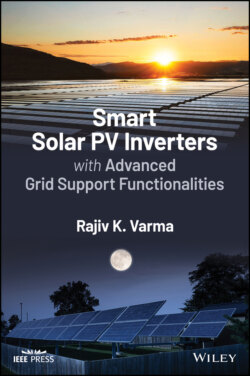Читать книгу Smart Solar PV Inverters with Advanced Grid Support Functionalities - Rajiv K. Varma - Страница 47
1.2.18.1 Under Frequency Response
ОглавлениеA study of the US Western Interconnection depicting the impact of extra high penetration of solar PV systems on overall system frequency response is described below [2]. This study considers a total renewable penetration of 80% (65% solar and 15% wind) at the interconnection level and 100% penetration (all PV) at a regional level.
A realistic model of the Western Interconnection is utilized. The 2022 Light Spring (LSP) planning case is considered due to the relatively low level of online synchronous generation during a light load condition. This represents an ideal (most severe) case to benchmark the frequency response performance.
The 2022 LSP case is implemented in GE’s Positive Sequence Load Flow analysis simulation software. The LSP case is modeled in detail with over 4000 generators and more than 19 000 buses. Each power plant has its own specific detailed dynamic models, including a generator, exciter, and turbine governor. HVDC systems and protective systems such as UFLS and line protection are also included in the Western Interconnection dynamic model. As PV systems are entirely based on inverters, they are represented by GE Type 4 wind power plant model. This includes the converter model, active and reactive power control model, and low‐voltage power logic [2].
The total generation in the 2022 LSP case is 117 GW; with approximately 13.9% instantaneous penetration of wind and 1.1% instantaneous penetration of solar PV. To increase PV penetration the existing synchronous generators are replaced by solar PV systems in each area, so no transmission upgrades are required. The generators are replaced in the sequence of coal power plants, gas generators, hydro generators, and then nuclear generators. As synchronous generators gradually get replaced by PV systems, the net system inertia decreases almost linearly, as shown in Figure 1.15 [2]. The system equivalent inertia level for the base case is 3.4 seconds. The inertia levels for 20, 40, 60, and 80% renewable penetration levels are noted to be 3.17, 2.31, 1.68, and 0.92 seconds, respectively.
The system frequency response is examined in terms of three metrics: (i) ROCOF which reflects the inertia response; (ii) frequency nadir which is determined by both inertia and PFR; and (iii) settling frequency which represents the PFR of the system.
Three severe contingencies are considered as follows:
1 Largest N‐2 contingency involving loss of two largest generators in the Palo Verde nuclear plant, equivalent to a loss of 2525 MW capacity.
2 Typical N‐2 contingency involving loss of two largest generators in the Colstrip coal power plant, representing a loss of 1514 MW capacity.
3 Typical N‐1 contingency involving loss of one large generator in the Comanche power plant, indicative of a loss of 904 MW capacity.
To demonstrate the severity of frequency decline as a result of different renewable penetration levels, models of all the protection systems including UFLS are disabled in this simulation. The frequency response for the largest N‐2 and typical N‐2 contingencies are portrayed in Figure 1.16 [2]. For both contingencies, increasing PV penetration worsens the overall frequency response. It increases ROCOF, lowers frequency nadir, and decreases settling frequency. The 2.6 GW generation loss with 80% PV penetration, causes the frequency to drop below 59.4 Hz triggering the first stage of UFLS. This implies that the Western Interconnection is not capable of hosting 80% solar PV due to its low inertia and diminished frequency response.
Figure 1.15 System equivalent inertia at different PV penetration levels.
Source: Modified from Tan et al. [2].
Figure 1.16 WECC frequency response under high PV penetration scenarios: (a) 2625 MW generation loss, (b) 1514 MW generation loss.
Source: Tan et al. [2].
Frequency response obligation (FRO) for the Western Interconnection is described as the power that the system must provide during the first couple of seconds after an event to prevent the decline of frequency and avoid activation of first stage of UFLS. The FRO is set at 906 MW/0.1 Hz which implies that the power from all the generators should increase by 906 MW for a frequency decline of 0.1 Hz. This FRO is updated by NERC every year, based on system measurements.
Studies on the Western Interconnection reveal that the prescribed FRO is met with 20, 40, and 60% renewables; however, it is not satisfied in case of 80% renewable penetration. The FRO is noted to be 599, 692, and 724 for the largest N‐2 contingency, typical N‐2 contingency, and typical N‐1 contingency, respectively. These values are much lower than the NERC specified FRO of 906 MW/0.1 Hz. This deficit of FRO will endanger the reliability and safety of the interconnected system.
